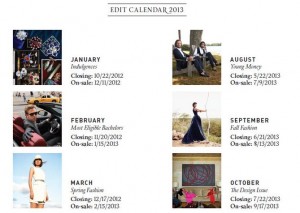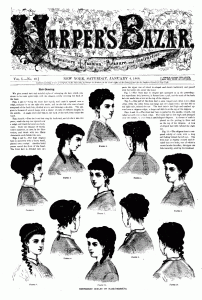Locating specific articles and images from pre-1970’s fashion and “women’s interest” periodicals can be difficult. Many of these magazines were given late or spotty coverage by the big publishing companies that provided periodical indexes to libraries (precursors to library databases). For instance, it wasn’t until the mid-1950’s that the Reader’s Guide to Periodical Literature began selective coverage of some women’s magazines: Vogue, Ladies Home Journal, McCall’s and the like. The coverage was far from comprehensive and not especially good for image research. Harper’s Bazaar didn’t get picked up until the early 1970’s and Women’s Wear Daily, was largely ignored by all indexers until the late 1970’s. As a result, if you wanted to find something specific – like an early Irving Penn photo in its original editorial context or a society article about the Marchesa Cassati -you either had to browse through issue after issue, or hope to find a reference in a secondary source such as a book.
That’s why the 2011 launch of the Vogue Archive online — with its full-text, full-image coverage of every page of Vogue from 1892 to  the present — revolutionized the way the research is conducted the area of fashion history (and popular culture, photography, illustration, communication design, etc).
the present — revolutionized the way the research is conducted the area of fashion history (and popular culture, photography, illustration, communication design, etc).
But what about all the other influential magazines from across the decades and around the world? Well, FIT Library’s subscription to General OneFile will let you to search for articles (text only) from many fashion and women’s interest magazines back into the 1980s or 90s, but if you need anything earlier little has changed.
So if you’re looking for Women’s Wear Daily articles about Nan Kempner lunching with Chessy Rayner, or if you’re hoping to find Warhol’s fashion illustrations as they originally appeared in Harper’s Bazaar, you might find yourself asking, “How do I look when it’s not in Vogue?”
Three Tips for “Looking Good”
1 . Do some informed browsing
The Educated Guess. Whether you’re looking for images, advertisements or textual information, remember that certain topics are going to get better coverage during certain times of the year or (in the case of newspapers) during certain days of the week. Just knowing a little something about a magazine’s intended audience and what might interest them seasonally can be a good place to get started. For example: If you’re looking for swimwear images from a particular decade in a magazine intended for a general female audience, you might ask to see the June or July issues. However, if the magazine is aimed toward individuals the fashion industry, you will likely find previews of summer swimwear in spring issues.
The Editorial Calendar. Along with making your best guess, you should be aware the most magazines and newspapers have “editorial calendars”. For magazines these calendars might vary slightly or broadly from year to year depending. But for many daily newspapers the weekly calendar is adhered to strictly decade after decade.
For example the Women’s Wear Daily weekly editorial calendar has been roughly as follows for years, if not decades:
Monday – Accessories
Tuesday – Textiles
Thursday – Menswear (since the folding of the Daily News Record in Nov. 2008)
Friday – Beauty
Therefore, when a researcher came to the reference desk recently looking for information on a lesser-known handbag designer from the late 60s and early 70s who specialized in canvas totes, she was told to browse the spring 1969 to 1971 Monday issues for previews of summer accessories.
Finding current editorial calendar for magazines is pretty easy and can give you insights into what past calendars may have been like. Simply search the web with the name of the magazine and the words “editorial calendar.” If that doesn’t work, look for

the magazine’s media kit. Here are examples of how widely editorial calendars can vary based on the intended audience.
Harper’s Bazaar
Town & Country
Seventeen
For a complete list of our periodical holdings in print, visit this page.
2. Use the New York Public Library’s databases.
You may want to get yourself a New York Public Library card to search for content earlier than 1980 or for content from foreign publications. The two databases below, both accessible from NYPL.org, should be used in conjunction with our print magazine holdings, as they will not necessarily provide you with page images or .pdf files of the articles they retrieve.
Reader’s Guide Retrospective (New York Public Library card/barcode required)
The FIT Library owns the Readers Guide to Periodical Literature in print format, but the New York Public Library provides online access to the Readers Guide Retrospective database which is much more comprehensive in its coverage than its print counterpart (click to see title list and date coverage). and includes Harper’s Bazaar from 1899-1982 & Mademoiselle from 1953-1982.
Design and Applied Arts Index (New York Public Library card/barcode required)
We used to subscribe to Design and Applied Arts Index until quite recently, but budget matters forced us to drop it. Like Readers’ Guide Retrospective, however, it is available online from the New York Public Library. It provides indexing coverage of Elle UK, Vogue UK and other foreign fashion magazines (no full-text articles).
3. Free magazine archives on the web
Historical magazine content is increasingly available for free online, but the quality of the images and the accuracy of search vary greatly from archive to archive. Coverage is also very spotting. The following are some of my favorite online archives, because they provide excellent indexing, full-text or/and full-image access to “womens’ interest” magazines.
Hearth from Cornell University Libraries – The Journals
 This amazing online archive allows you to browse and search a wide range of materials related to home economics. In the listing of journals you will find Harper’s Bazaar 1867-1900 and Good Housekeeping 1885-1950.
This amazing online archive allows you to browse and search a wide range of materials related to home economics. In the listing of journals you will find Harper’s Bazaar 1867-1900 and Good Housekeeping 1885-1950.
HathiTrust is collection of millions of titles digitized from academic libraries around the world. To locate and exclusively search the contents of fashion or women’s interest magazines, forego using the “full-text” search. Instead, click on the “catalog” search tab and search for either “fashion periodicals” or “women periodicals” in the Subject field. 
Titles include: La Moda elegante ilustrada, Woman’s Home Companion, and Repository of arts, literature, fashions. Dates of holdings vary widely, but the nineteenth and early twentieth centuries are well covered
French fashion magazines publishing house, Les Editions Jalou, made the bold and generous decision to make the archives of all their magazines either fully or partially available, including L’Officiel de la Mode 1921-2013 and L’Art et la Mode 1883-1965. The magazines can be searched and browsed by decade. Pages can be printed out but not downloaded. This video illustrates how the browsing feature works.
Ebony magazine 1950-2008 can be accessed from Google Books, as can Elle Girl 2001-2007, Working Mother, 1978-2008, and other general interest magazines.
Leave no page unturned! My suggestion is that you give all of these options a try and certainly don’t cheat yourself out of the experience of looking through our older magazines. And if you ever need any help, come by the reference desk on the 4th floor of the FIT Library or contact us via our Ask a Librarian services.

Things change so quickly in the the world of information – Women’s Wear Daily is currently being archived and made searchable! The FIT Library has a brand new trial to it now! Check it out https://www.proquest.com/trials/trialSummary.action?view=subject&trialBean.token=MS0VP2PGA0OTOPXIHQKX